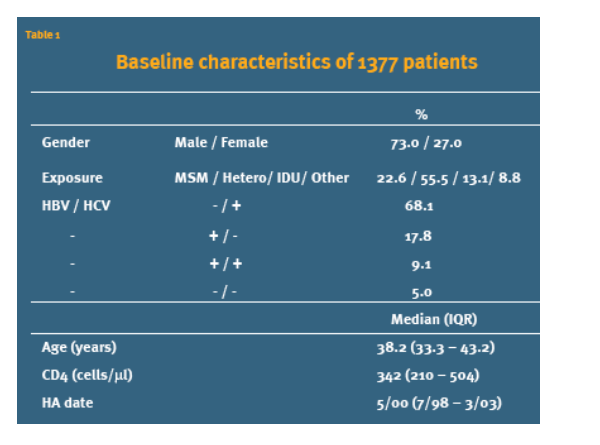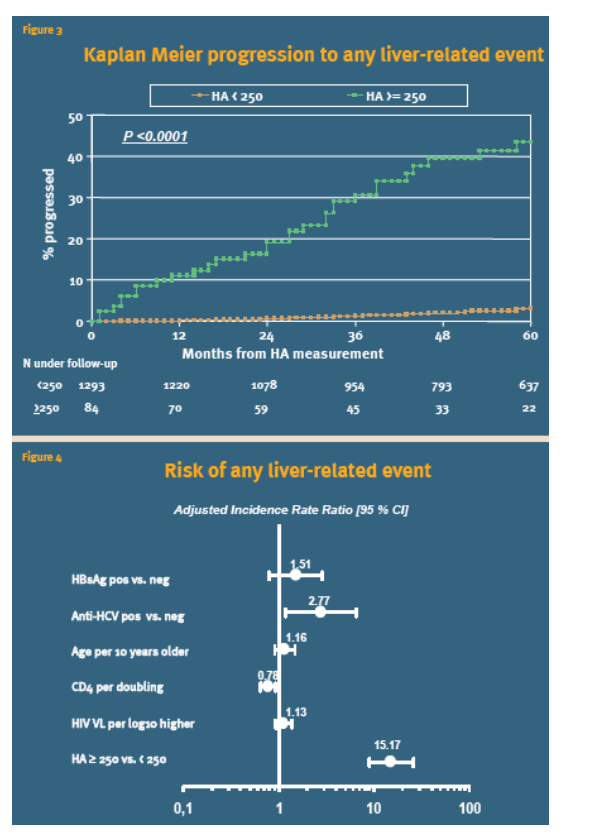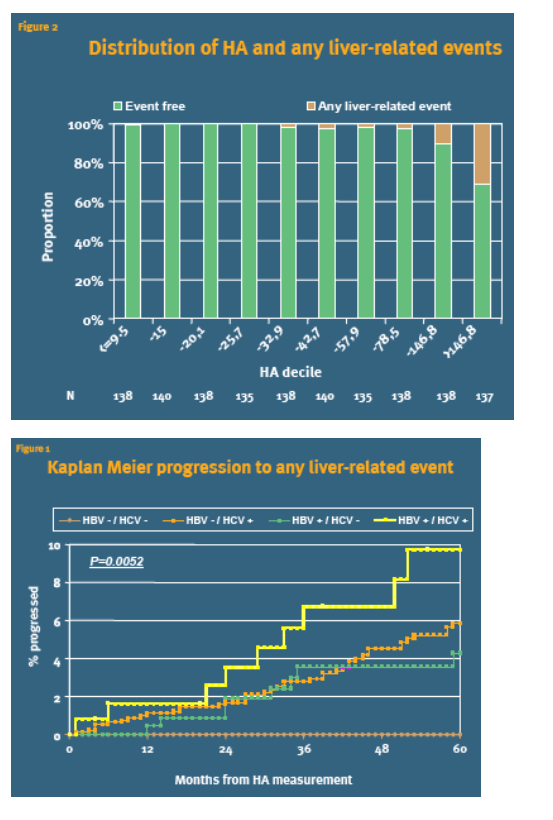 |
 |
 |
| |
Hyaluronic Acid as a Prognostic Marker of Hepatic Coma and Liver-related Death in HIV/Viral Hepatitis Co-infected Patients
|
| |
| |
Reported by Jules Levin CROI 2009 Montreal Feb 8-12
"HA is a strong predictor of liver-related events in HIV/viral hepatitis-co-infected patients. Patients developing liver-related events during follow-up had substantially larger increases in HA compared to patients without such events. Higher CD4 counts are associated with a reduced chance of substantial increases in HA levels during follow-up, consistent with the assumed protective role of high CD4 counts on risk of liver-related events in co-infected patients. Therefore, plasma HA may be useful to monitor progression of liver disease in this population."
Lars Peters*1, A Mocroft2, V Soriano3, J Rockstroh4, B Ledergerber5, A Karlsson6, B Knysz7, C Pradier8, K Zilmer9, J Lundgren1,10, and the EuroSIDA Study Group
1Copenhagen HIV Prgm, Univ of Copenhagen, Denmark; 2Royal Free and Univ Coll Med Sch, London, UK; 3Hosp Carlos III, Madrid, Spain; 4Univ of Bonn, Germany; 5Univ Hosp Zurich, Switzerland; 6Venhalsan, Sodersjukhuset, Stockholm, Sweden; 7Department of Infectious Diseases, Wroclaw Medical University, Wroclaw, Poland; 8CHU Nice Hopital de l'Archet 1, Nice, France; 9West-Tallin Central Hospital, Tallinn, Estonia; and 10Centre for Viral Disease/KMA, Rigshospitalet, Copenhagen, Denmark
Background: There is a lack of studies of biomarkers predicting risk of liver-related events (hepatic coma or liver-related death) in HIV-infected persons also infected with hepatitis B (HBV) or hepatitis C virus (HCV). We investigated plasma hyaluronic acid (HA) as a prognostic marker for liver-related events in the EuroSIDA study.
Methods: Patients positive for anti-HCV antibodies or hepatitis B surface antigen and at least one available plasma sample were included (n = 1377). The first available plasma sample was tested for HA (normal range 0 to 75 ng/mL) in all patients, as was the last for patients who developed a liver-related events during follow-up (cases) and in a random selection of one sixth of the remaining patients (controls). Poisson regression was used to explore factors associated with clinical progression.
Results: Median follow-up was 4.9 years (IQR 2.8 to 7.6); 68 patients developed a liver-related events. The baseline median HA in those without a liver-related events was 31.2 ng/mL (IQR 16.8 to 61.1), compared to 247.1 (IQR 116.7 to 618.9) in those with a liver-related events. The crude incidence rate (per 1000 person-years of follow-up) of liver-related events for patients with HA _250 was 108.6 (95%CI 72.1 to 145.1) vs 5.0 (3.3 to 6.7) in patients with HA <250, crude incidence rate ratio (IRR) = 21.5 (13.5 to 34.8, p <0.0001). After adjustment for other confounding variables, HA (per log10 higher) was the best predictor of a liver-related event (IRR = 18.1; 11.2 to 29.3, p <0.0001). HA was also an independent, but weaker, predictor of non-liver-related deaths (IRR = 1.51; 1.01 to 2.24, p = 0.044), but not AIDS (IRR = 1.16; 0.77 to 1.76, p = 0.47). During follow-up the median time between HA measurements was 2.4 years (IQR 1.4 to 4.3 years). Median change in HA/year was 103.5 (IQR to 7.4-212) for the cases (n = 48) and 1.06 (IQR -4.8 to 8.3) for the controls (n = 194), p <0.0001. CD4 (per doubling) and being a case were the best predictors of >1 standard-deviation (189 ng/mL) increase in annual HA; odds ratio (95%CI) 0.64 (0.44 to 0.92), p = 0.015 and 8.6 (3.1 to 23.5), p <0.0001, respectively.
Conclusions: HA is a strong predictor of liver-related events in HIV/viral hepatitis-co-infected patients. Patients developing liver-related events during follow-up had substantially larger increases in HA compared to patients without such events. Higher CD4 counts are associated with a reduced chance of substantial increases in HA levels during follow-up, consistent with the assumed protective role of high CD4 counts on risk of liver-related events in co-infected patients. Therefore, plasma HA may be useful to monitor progression of liver disease in this population.
Study end points
The primary end point was the composite of liver-related death (LRD) or the development of hepatic encephalopathy, while secondary end points were non-liver-related death and development of AIDS. Deaths were classified as "liver-related" if clinical or autopsy diagnoses described either liver failure, chronic viral hepatitis, peritonitis, hepatocellular carcinoma, hepatic encephalopathy, oesophageal
bleeding, other gastro intestinal bleeding in the presence of cirrhosis/end-stage liver disease, liver failure in the presence of acute bacterial infection in patients with previously known end-stage liver disease or medication-related hepatotoxicity resulting in hepatic failure. Hepatic encephalopathy was defined as grade 3 or 4 based on the West Haven Criteria of Altered Mental Status In Hepatic Encephalopathy (Ferenci et al; Hepatol0gy 2002).
Hyaluronic acid
Quantitative determination of HA in stored plasma samples was performed in the first available plasma sample after being tested positive for anti-HCV and/or HBsAg using a commercial enzyme linked binding protein assay (Corgenix, Colorado, USA) with a HA range in a healthy population between 0-75 ng/mL. Each HA level was measured in duplicate. All patients that developed a LRE during follow-up had HA measured in their last available sample prior to their event. As a control group, a random selection of one sixth of the remaining patients also had HA measured in their last available plasma sample.
RESULTS
Baseline HA and risk of clinical progression
The baseline characteristics of the 1377 included patients are shown in table 1. The median baseline HA level for all patients was 32.9 ng/mL (interquartile range [IQR] 17.4 - 65..5). Median HA (IQR) for the four patient groups (HBV-/HCV+, HBV+/HCV-, HBV+/HCV-, HBV /HCV-) was 34.3 (18.3 - 70.3), 29.4 (16.6 - 56.9), 33.1 (19.3 - 90.4) and 19.5 (11.9 - 38.2), respectively.
During a median follow-up of 4.9 years (IQR 2.8 - 7.6 years) 68 (4.9%; 44 LRD and 24 hepatic encephalopathy) patients developed a liver-related event (LRE). Patients positive for both HBV and HCV progressed fastest to a LRE, while none of the HIV monoinfected patients experienced an event, figure 1. For patients who developed a LRE during follow-up the median HA was 247.1 ng/mL (IQR 116.7-618.9), while it was 31.2 ng/mL (IQR 16.8 - 61.1) for patients who did not experience a LRE. Figure 2 shows the distribution of HA for all patients
divided in to deciles; the proportion of patients experiencing any LRE was low with low HA. 57 (83.8%) events occurred with a baseline HA >146.8 ng/mL, while only one out of 551 with a baseline HA <25.7 ng/mL experienced an event. Figure 3 shows a Kaplan-Meier plot for any LRE using the median HA (250 ng/mL) for stratification. Having a baseline HA of less than 250 ng/mL resulted in a cumulative 5 year risk of experiencing a LRE of 3.0%, while the 5 year risk was 43.6% for patients with a baseline HA higher than 250 ng/mL. For HA > 75 vs. < 75 ng/mL the corresponding 5 year risks of experiencing a LRE were 21.7% and 0.86%.
HA as predictor of development of clinical events
The multivariate incidence rates ratios (IRR) for any LRE are shown in figure 4. HA (> 250 vs. < 250 ng/mL) was by far the strongest predictor of any LRE with an IRR of 15.17 (IQR 8.94 -25.75, p<0.0001). For the development of AIDS and non-liver-related death the IRR for HA (> 250 vs. < 250) was 0.83 (IQR 0.38 - 1.85, p=0.65) and 1.63 (IQR 0.91 - 2.93, p=0.10), respectively.
HA at follow-up
48 (70.6%) patients that developed a LRE during follow-up had HA measured in their last available sample prior to their event (cases). 194 (14.8%) patients were included as controls. 25 (52.1%) of the cases had an increase in HA of more than 100 ng/mL, while 12 (25%) had decreasing HA. 6 cases had a HA <75 ng/mL at follow-up, one of them decreasing from a HA higher than 250 ng/mL at baseline. Of the controls only 10 (5.2%) had an increase in HA of more than 100 ng/mL, while 81 (41.8%) had decreasing HA. 12 (6.2%) controls had a HA
>250 ng/mL at follow-up.
For the cases the median change in HA per year was 103.5 ng/mL (IQR -7.4 to 212.0), while it was 1.06 ng/mL (IQR -4.75 to 8.27) for the controls, p<0.0001 for comparing the median annual change.
As change in HA was not normally distributed, we used logistic regression to look at odds of >1 standard deviation (SD) (189 ng/mL) increase in HA. In the univariate analysis cases had a 11-fold increased odds of >1 SD in HA (odds ratio [OR] 11.0, 95% confidence interval [CI] 4.14 - 29.25, p<0.0001). In multivariate analysis, predictors of >1 SD change in HA were CD4 (per doubling) (OR 0.64, 95% CI 0.44 - 0.92, p=0.015) and being a case (OR 8.58, 96% CI 3.13 - 23.53, p<0.0001).
SUMMARY AND CONCLUSIONS
· Baseline HA level was a very strong predictor of later development hepatic encephalopathy or liver-related death in HIV-1 patients coinfected with HBV and/or HCV
· Patients, who during follow-up experienced a liver-related event, had higher annual increase in HA compared to patients without an event
· A high CD4 cell count reduced the risk of increasing HA, consistent with the assumed protective role of high CD4 cell counts on the risk of LRE in coinfected patients
· Therefore, plasma HA may be useful, either alone or in combination with other non-invasive methods to monitor progression of liver disease in patients with chronic viral hepatitis



|
| |
|
 |
 |
|
|